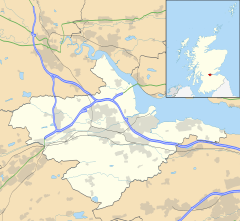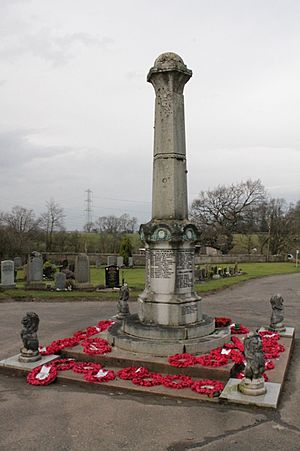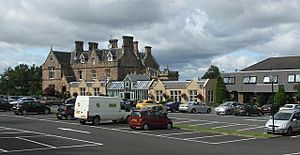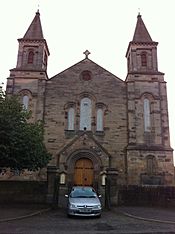Polmont facts for kids
Quick facts for kids Polmont
|
|
|---|---|
 Top: Parkhill House, Middle: Union Canal, Bottom left: Old Polmont Reservoir and golf course Bottom right: Meadowbank Library. |
|
| Population | 5,040 (2020) |
| OS grid reference | NS936788 |
| Civil parish |
|
| Council area | |
| Lieutenancy area |
|
| Country | Scotland |
| Sovereign state | United Kingdom |
| Post town | FALKIRK |
| Postcode district | FK2 |
| Dialling code | 01324 |
| Police | Central Scotland |
| Fire | Central Scotland |
| Ambulance | Scottish |
| EU Parliament | Scotland |
| UK Parliament |
|
| Scottish Parliament |
|
Polmont (Scottish Gaelic: Poll-Mhonadh) is a village in the Falkirk council area of Central Scotland. It is located towards the east of the town of Falkirk. The Union Canal runs right next to the village, just north of it.
Because Polmont is in Central Scotland, you can see many different places from here. These include the Ochil Hills, the River Forth, and even Cairnpapple Hill. While there is a prison called Polmont Young Offenders Institution, it is actually located in a different village called Reddingmuirhead.
Contents
Polmont's Past
The name Polmont comes from a Scottish Gaelic phrase, Poll-Mhonadh. This means "Pool of the Hill" in English.
Old Polmont was built on a raised beach. It looked out over the Firth of Forth and the Ochil Hills. The Romans had two temporary marching camps here. One was called Little Kerse, and the other was Polmont Hill. The famous Antonine Wall, built by the Romans, also ran through Polmont. You can still see parts of the wall in Polmont Woods. You can reach them by a footpath near the M9 motorway bridge.
Polmont was first mentioned in records in 1498. This was about the Chapel of the Blessed Virgin Mary. In 1968, the first part of the M9 motorway was built. It cut through farmland between Old and New Polmont.
Polmont was originally part of the Falkirk area. But in 1724, it became its own independent parish. A parish is like a local church district. The area was later renamed Grangemouth Parish as the port of Grangemouth grew.
New Polmont was built along the Great North Road (A9). It was south of Old Polmont. It was first called Bennetstown, named after Mr. Bennet, who owned the land. New Polmont had homes, farm workshops, and stores. It also had three pubs: The Crown, The Red Lion, and The Black Bull. Only The Black Bull is still there today. It dates back to before 1745.
The village slowly grew after World War II. More houses were built on land that used to be large estates. From the mid-1970s, many more houses were built. This made Polmont a "dormitory town," meaning many people live there but travel to other places for work.
During World War II, a school for girls called St Margaret's was in Polmont. It was used by Polish forces for signals training. Soldiers from different Polish units were stationed there.
Famous People from Polmont
- John Gibb Dunlop (1844–1913) was a director of John Brown and Company. This company built famous ships like the RMS Lusitania.
- Gilbert Laurie of Polmont (1729–1809) was a Lord Provost of Edinburgh. This is like being the mayor of Edinburgh.
- Johan Theodor Salvesen (1820–1865) helped start the company Christian Salvesen.
- James Smith (1808–1863) moved to Polmont Bank House. He came with his daughter, Madeleine Smith, to escape public attention.
Polmont's Economy
Polmont's economy mainly relies on small local businesses. These include pubs, cafes, hotels, take-aways, and convenience stores. Most of these are found in or near the Polmont shopping centre.
Agriculture is also important, with a lot of farmland in the area. Polmont is also home to the Avondale Landfill. This is a large employer on the east side of the village.
Many people who live in Polmont work at the Grangemouth refineries and port. This is because Grangemouth is very close by. Not many people work in Polmont itself. This makes it a "commuter town," where people travel to cities like Edinburgh and Glasgow for their jobs.
There are several hotels in the area. The most well-known is the Inchyra Grange. This hotel was once a large mansion.
Getting Around Polmont
Polmont railway station is on the Edinburgh to Glasgow railway line. In 1984, there was a train incident near Polmont. A train collided with a cow that had wandered onto the tracks.
The M9 motorway goes through the village, between Polmont and Old Polmont. It has two exit points on the east and west sides. There are many bus stops throughout the village. Most are on Polmont Main Street. These buses provide direct services to Edinburgh, Falkirk, and Stirling. The closest airport is Edinburgh Airport, which is about 17 miles (27 km) to the east.
Learning in Polmont
Polmont has offered primary school education since the 1700s. The original Parish School building is still across from the church. In the 1960s, Polmont Primary School became too crowded. It moved to a new building on Greenpark Drive. The school's colours are green and silver.
As Polmont grew, the school again became too crowded. A new, permanent building was built in the southwest of Polmont. It was renamed St Margaret's Primary School. St. Margaret's was also the name of a private school that existed between 1895 and 1948.
Polmont's Culture
Polmont Parish Church was designed by John Tait in 1844. Polmont is a parish, and most of its religious community is Christian. There is a Church of Scotland in Old Polmont. Other Christian groups like the Church of the Brethren and the Religious Society of Friends are also present.
The Scottish rock band Glasvegas has a song called "Polmont On My Mind." It is on their first album, Glasvegas.
Parkhill House and its grounds were used as a filming location for the TV series Outlander (TV series). It was turned into a graveyard for the show.
The grounds of the former Millfield House still exist. They include a bowling green with steps and two beautiful Canadian redwoods. There are also remains of a lily pond and a wildfowl lake.
In 2023, Polmont won the "best small town" award in the Scotland in Bloom competition for the first time.
Sports in Polmont
Football
Polmont has an amateur football club. Since the 2014–15 season, they have played in Division One of the Stirling & District AFA. The club plays its home games at Meadowbank Bank, St. Margaret's. There used to be a junior club in the area, but it only lasted a few years. Another club, Rumford Rovers, played at a higher level for a short time in the 1890s.
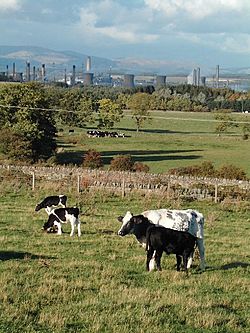
The most famous football player from Polmont is Alex Raisbeck. He was captain of Liverpool for many years. He also played for the Scotland eight times. He was considered one of the best players of his time, starting in 1898. He led Liverpool to win their first ever English championship title in 1901. He did it again five years later.
Another well-known player from Polmont is Derek Niven. He used to play for Chesterfield.
Other Sports
Even though it's called Grangemouth Golf Club, it's actually located on the edge of Polmont.
Inside the Grangemouth Golf Club area is Millhall Reservoir. This is now used for fishing. To the east of the clubhouse is Polmont Ski Centre. It has an artificial ski slope where you can practice skiing.
See also
 In Spanish: Polmont para niños
In Spanish: Polmont para niños


